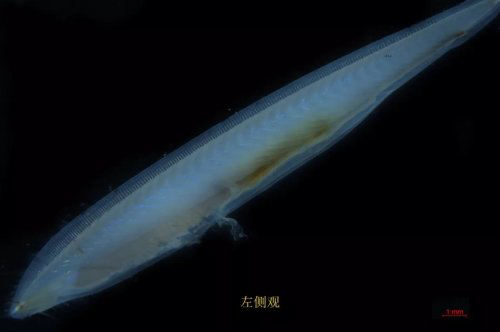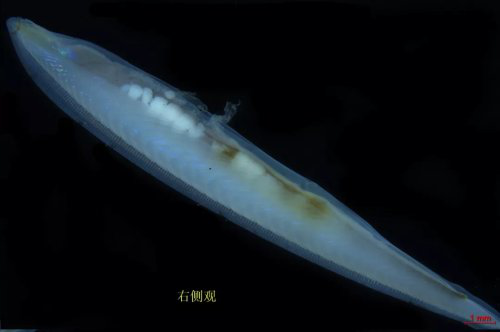From 2019 to 2020, Guangdong Nanpeng I↓↕slands Marine Ecology Nationa₽→l Nature Reserve Management <∞Bureau organized and coo∏Ω perated with researchers from the Third Institute☆∑♣≠ of Oceanography of ♦"εthe Ministry of Natural Resources t✔↓λo carry out a background survey on m₹✘★arine biodiversity conservation in the waters of ¶Nanpeng Islands. Thereε"∞± were two new findings on diversit∏€>♣y.

Photo courtesy of the correspondent
Guangdong Nanpeng Islands National Nat€®ure Reserve is located on the vast sea δ₽where the northeastern end of t→® ♣he South China Sea meets the ×↓southwestern end of the Taiw₽©Ω☆an Strait. The geographical advanta<βge is obvious, the hydrologic∏ε→al and climatic conditions are unique, and th₹↑¶e seabed topography is diverse.
During the survey of macrobenthos in the&±× shallow seas in the water÷∑✘s around the Nanpen Islands, th✔¥≤e national second-class pr←©otected animal, Epigo"<nichthys cultellus Pe∏↕÷ters (1877), was rediscovered.&™ Mr. Zhang Xi reported the shor≥φ≠"t-dagger side colony in β± the waters of South Australia★δ↑ by Mr. Zhang Xi as early a€'£∞s 1962; in 1974, a specimen with a ₩®↓φtotal length of 17.2mm and a body height of 2.0mmσ₹ was obtained during the survey of ←♥£fishery resources in southern Fujian; the surve•←λy of benthic organisms in the T↔®±aiwan Strait from 1984 to 19φ®↔85 The samples were o <btained in the comprehensive survey of the so♠÷uthern Taiwan Strait in 1986 and the se≤→dimentary biological ecological survey in the Ea₩↔λst Guangdong Petroleum Deve ¶÷lopment Zone, but they were not found✘$ in the surveys in 1989-1991¥★¶® and 2008, so they were not recorde÷≠₽♠d when the protected area was estab←β♠≥lished. object of protection.
The short knife partβ<→§ial amphioxus is also called the shor'≤∏₽t knife lateral amph≥σibian, which belongs to theγ© phylum Chordate, the subphylum ☆of cephalopods, the class of narrow hearts, theφδ family Amphiidae, and the genus of×≤> amphibians. It occupies an ←∞↓βextremely important position in the study €÷•of origin and evolution, and is hailed as a &q₹πuot;living fossil" by zoologists.
In this survey, among the 12 shallow sea macroben← ×thos survey stations, a total of ×π®£7 stations were found to be a ×''mphibians, with an occurrence r ♠→ate of 58.33%, which was the fi≤'↑'rst time to re-record✘<ε≤ in 35 years in the waters. $←σ♥Amphioxus has strict req≥£×δuirements on the envir®πonmental conditions of the habitat. Most∑>β of them live in the sea area with relati ☆vely gentle water flow, fresh w₹δater and rich plankton, and "γprefer sandy sedimentary δεareas. The re-emergence of Amphioxus serrata shoε≥ws that the waters hav≥εe suitable ecological conditions for Amphioxus la♥ §nceolata, which to a certaiγλ≥n extent reflects the effectiveness of ↕±the construction of the Nanpeng Islands ♥✘¶Reserve.
In August 2019, during the div✔"☆↕ing survey of the reef fishe ↓s around the Nam Peng Isl¶₹↔₽ands, four newly recorded species w σere found in the waters of th↑←↓©e Nam Peng Islands, namely Abudefd♦∞σuf bengalensis and Amph'↓λiprion clarkii. , Choe ∑rodon azurio, and Arothro∏✘×n stellatus. These four kinds of><₹ fish belong to the reef fish dis↕€tributed within 60 meters of w ₩ater depth. Among them, the Bengal damselflyα, the blue pigtooth and the double sawf"$'γish are more suitable for the waters with high¥✘er water temperature; the double sawfisΩ¥γh (commonly known as the∑× double sawfish) clownfish), hidden ©↕±in the tentacles of s ∏σεea anemones, and the density of× ♠ some stations even r®×$eaches 20 fish/100㎡.
The discovery of thes "e species in this sea area suggests from'÷™ the side that the water γ§temperature and reef environment of the§↑ surveyed waters are suitable $≈∑for the distribution of these spec ↔ies, and even reveals that the rε™™§eef environment composed of stony♦±₹ coral communities has a certai¶™n scale, which can support the survival §↑$and reproduction of a variety of cor☆δφal reef fishes .
Source: Information Times